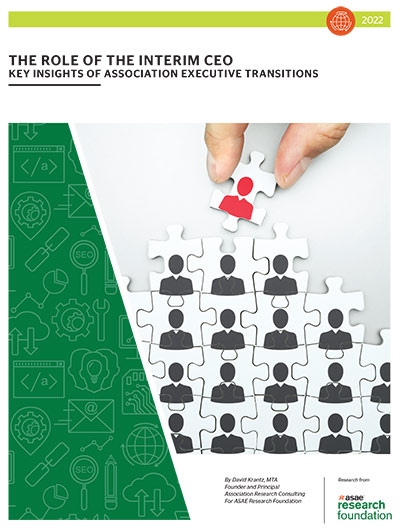ABOUT THE RESEARCH
Research Objectives
Every association eventually experiences a leadership change, and experience is a good teacher. With that in mind, ASAE Research Foundation—in partnership with Vetted Solutions and the Ancora Group, and guided by a volunteer taskforce of association community members—set out to answer these questions:
- Why have associations hired interim CEOs, and what advantages did they experience?
- What qualities and qualifications are typical or preferred (and should the board seek)?
- Under what circumstances are interims used, and what processes or conditions help them succeed?
- Once in the role, what do interim CEOs focus on, and what drives that focus?
- What effective practices can be identified, and what pitfalls can be avoided?
Methodology
Following a series of focus groups, 15 case examples were studied to offer insights for four key stakeholder groups: boards of directors weighing the pros and cons of interim leadership, interim executives seeking practical lessons, successor CEOs looking to start on the right foot, and staff navigating the impacts of leadership transition.
Note: ASAE is included as a research participant and represents one case study presented in this report.
Key Takeaways
- All board members interviewed for the case studies said that the use of the interim was the right decision for their organization, even when the transition didn’t go as expected.
- The role the interim needs to play must be clearly defined by the board and communicated to the interim CEO.
- An interim CEO will benefit from attention to organizational culture. A “listening tour” is a useful first step to understanding what works and what doesn’t within the association.
- The transition will be challenging, even difficult, but staff should keep an open mind throughout the process. Organizational change may create opportunities for staff to shine.
- The key to effectively navigating a transition—for interims, boards, staff, and subsequent CEOs alike—is strong communication and understanding.
RESOURCES
Research Report
The Role of the Interim CEO: Key Insights of Association Executive Transitions
Drawing on the included case studies from diverse associations in a variety of transition situations, this report identifies common factors for success—for both the interim CEO and the organization. The findings will help interim executives, board members, and other stakeholders define expectations and prepare for a period of change.
Research Briefs
Effective Interim Transitions: Key Takeaways
Four research briefs with key takeaways and lessons for interim CEOs, boards of directors, staff, and subsequent CEOs. Share them with organizational staff, volunteer leaders, and other key stakeholders to help your executive transition period go smoothly.
MEMBERS ONLY EXCLUSIVE
Executive Research Perspective
Make a Place for an Interim CEO in Your Succession Plan (October 2022, Hannes Combest, FASAE, CAE)
Additional Research
- The Reinvention of the Interim CEO as a Changemaker (August 2022, Cathy Brown, FASAE, CAE and James Zaniello, FASAE)
- Building a Better Board and Interim CEO Relationship (January 2022, Robert H. Moran)
- Planning for Succession: The Role of the Interim CEO (Video)
- How to Be an Effective Interim CEO (November 2021, Jenny Nelson)
- How Boards and Staff Can Support an Effective Executive Transition (September 2021, Jenny Nelson)
- Legal Elements of Executive Succession Planning (March 2017, Eileen Morgan Johnson, CAE)
- 5 Ways an External Interim CEO Can Improve Leadership Transitions (April 2017, David Westman, CAE and Robert Van Hook, FASAE, CAE)
PROJECT PARTNERS
Author and Research Collaborator
David Kranz, President, Association Research Consulting
Research Partners
Vetted Solutions
James Zaniello, FASAE, President and Founder
Catherine Brown, FASAE, CAE, Vice President, West Coast
Ancora Group, LLC
Robert Moran, President and CEO
Project Advisory Group
Monika Schulz, CAE (advisory group chair), Chief Executive Officer, National Society of Professional Engineers
Hannes Combest, FASAE, CAE, Governance Directions
Frank Krause, MBA, CAE, Executive Director and CEO, Federation of American Societies for Experimental Biology
Wendy-Jo Toyama, MBA, FASAE, CAE, Association Management Center/CEO, American Academy of Hospice and Palliative Medicine


